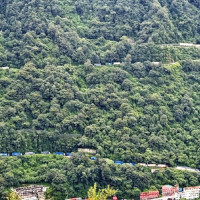- Tuesday, 11 November 2025
Vegetable farming thriving in Ghumaune
By Kaviraj Ghimire.Hile, Sept. 25: While many v illages in Dhankuta are losing their young people, the youth of Mahalaxmi Municipality-1 can still be found working in their own villages.
They spend their days busy in the fields. Unlike other places, locals in the area are neither drawn to foreign employment nor are eager to move to urban areas. The reason is vegetable farming.
For most farmers in the higher areas of Mahalaxmi Ward No. 1, vegetables are the main source of income. “Because of vegetable farming, we do not need to think of other options,” said local Devi Gurung. “It fulfils all our needs, so we never thought about going abroad or moving elsewhere.”
In Chitre, Ghumaune and Jor Thumki villages of this ward, around 350 households live almost entirely on vegetable farming. Unlike elsewhere, there is no shortage of workers here. As a result, no land is left fallow, and labour shortages are never a problem.
Neighbours help each other with planting, weeding and harvesting in turns. “Since everyone has the same work to do, it makes sense to do it together rather than separately,” said local farmer Benuka Gurung.
This area once grew only potatoes, but commercial vegetable farming began around 2003. Now, alongside potatoes, farmers grow cabbage, cauliflower, radish and peas.
According to local farmer and ward chair Tek Bahadur Gurung, individual farmers earn between Rs. 500,000 to Rs. 3 million annually from vegetable sales. He claimed that vegetables worth more than Rs. 200 million are exported from this ward alone each year.
According to the Agriculture Knowledge Centre in Dhankuta, vegetables are cultivated on 5,997 hectares of land in the district, producing 137,447 metric tonnes annually.
Of this, more than 3,500 hectares are in the highlands. Vegetables grown in the area are supplied not only to Jhapa, Morang and Sunsari districts in the Tarai, but also to markets across the Indian border.



-original-thumb.jpg)










